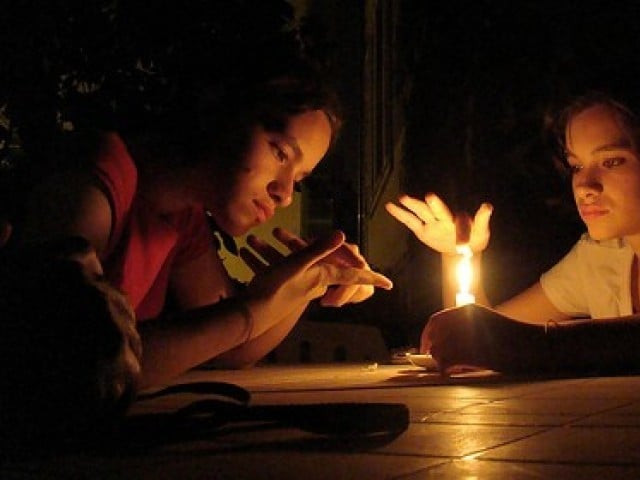No respite from power outages this summer
Load management introduced for areas with greater losses, lower recoveries

PHOTO: FILE
It has been almost three years since the Pakistan Muslim League-Nawaz (PML-N) was voted to power, but it could not fulfill its main election promise of reining in the chronic electricity crisis in the country.
Consumers will be subjected to 6-8 hours load-shedding daily this summer, according to a load management plan announced on Tuesday.
Resolution passed: Speaker suggests FIRs against power utility
The water and power ministry announced that a ‘special load management plan’ has been chalked out for areas with greater losses and lower recoveries. It added that the urban centres would be subjected to six-hour outages daily, while in the rural areas the load-shedding duration would be eight hours.
According to the plan, industrial consumers will be exempted from power outages, but in peak summer months, an industrial load management plan might be introduced.
This strategy has been devised keeping in view the principle of equality in terms of recoveries and losses, said a spokesperson for the water and power ministry. “Responsible consumers should be subjected to less load-shedding as compared to non-payers or electricity pilferers.”
In the areas where recoveries are up to the mark and losses within the permissible limit, load-shedding hours will remain predictable, he added.
The spokesman said a percentage-wise schedule for each 11Kv electricity feeder has been issued based on recoveries and losses, whereby high loss/theft areas would be subjected to higher than the announced load-shedding.
“The ministry also directed all the distribution companies (Discos) to prominently display each and every feeder losses and recoveries status at their circle offices, subdivision level offices, complaint centres and other prominent places in every city for public awareness,” the statement said.
It will now become possible for consumers of a particular feeder to adjust their load-shedding hours by paying their bills and by assisting their respective distribution company to act against power theft.
The ministry said as compared to 60% use of power capacity availability in 2013, the expected generation this summer was estimated at 85% of the generation capacity. However, on Monday, the country witnessed a shortfall of 4,200MW as power generation stood at 12,600MW against a demand of 16,800MW.

The PML-N government has set up three new power plants – 425MW Uch-2, 425MW Nandipdur and 747MW Guddu power plants. But the government is facing constraints to operate them fully as it is unable to dispatch 425MW power from the Uch-2 power plant due to the transmission line issue.
Facing the brunt : Areas with ‘medium’ to ‘very high’ losses cannot be exempted from load-shedding: K-Electric
The Nandipur power plant is not fully operational due to an issue with the fuel treatment plant, and gas has been diverted from the Guddu power plant which is also not functioning fully. There is another 600MW Guddu rehabilitated power plant and the overnment can add 1,500MW power to the national grid if these power plants are commissioned fully.
After coming to power, the PML-N government had released Rs480 billion to Independent Power Producers (IPPs) enabling the power sector to add 1,400MW to the national grid. But these dues have again ballooned to Rs320 billion leading to less power generation.
The dip in global oil prices had led to a cut in power generation cost in Pakistan but the government did not pass on full relief to consumers as it burdened them with Rs160 billion by imposing tariff rationalisation and financial cost surcharges. The government also limited subsidy to the power sector for consumers using up to 200 units per month.
The government claims that transmission losses have come down but they are still at the level of 19.5%. The National Electric Power Regulatory Authority (Nepra) had allowed the power firms to recover 16.5% from consumers whereas remaining 3% was being borne by power firms from their own profit.
The power sector still faces financial constraints as the Federal Board of Revenue (FBR) has withheld refund worth billions of rupees. The power sector claimed refund of Rs120 billion whereas the FBR believed the amount was Rs60 billion. The water and power ministry claimed that the finance ministry had not released over Rs100 billion to the power sector on account of price differential claims.
An official said the load-shedding situation was better last year compared to 2013. But it was not because of efficiency of the power sector. Last year, temperature had improved and therefore, demand remained less, he said.
“In June 2012, maximum power generation was 16,100MW while it was 16,800MW last year despite the fact that the government installed three new power plants,” he said. “These are the constraints which add to the power sector miseries – and the government is still facing problems to overcome outages,” he added.
However, the power sector has improved recovery of bills during the PML-N government. “The recovery of bills has jumped up from 86% to 93%,” the official said, adding that despite improvement in recovery, consumers were still facing miseries of outages.
Published in The Express Tribune, April 20th, 2016.





1675249047-0/image-(18)1675249047-0-208x130.webp)













COMMENTS
Comments are moderated and generally will be posted if they are on-topic and not abusive.
For more information, please see our Comments FAQ